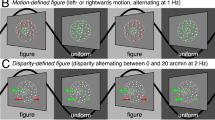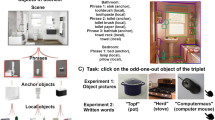Abstract
In the visual world, objects are partially occluded by nearer objects, separating them into image fragments. However, the image fragments of the object can easily be grouped and organized together by the visual system1,2,3,4. Psychophysical data1,2,3,4 and theoretical analysis5 indicate that such perceptual grouping might be mediated in the early stages of visual processing. Here I show that some orientation-selective cells in the primary visual cortex (V1) have response properties that can mediate the grouping of image fragments. These cells stopped responding to a stimulus bar when it was partly occluded by a small patch. The cells also did not respond when the patch had uncrossed disparity so that it appeared to be behind the bar. However, the cells began responding again when the patch had crossed disparity so that it appeared to be in front of the bar. These results indicate that cells as early as V1 have the computational power to make inferences about the nature of partially invisible forms seen behind occluding structures.
This is a preview of subscription content, access via your institution
Access options
Subscribe to this journal
Receive 51 print issues and online access
$199.00 per year
only $3.90 per issue
Buy this article
- Purchase on Springer Link
- Instant access to full article PDF
Prices may be subject to local taxes which are calculated during checkout



Similar content being viewed by others
References
Nakayama,K., Shimojo,S. & Silverman,G. H. Stereoscopic depth: its relation to image segmentation, grouping, and the recognition of occluded objects. Perception 18, 55–68 (1989).
Shimojo,S. & Nakayama,K. Amodal representation of occluded surfaces: role of invisible stimuli in apparent motion perception. Perception 9, 285–299 (1990).
Nakayama,K. & Shimojo,S. Experiencing and perceiving visual surfaces. Science 257, 1357–1363 (1992).
Nakayama,K. Binocular visual surface perception. Proc. Natl Acad. Sci. USA 93, 634–639 (1996).
Grossberg,S., Mingolla,E. & Ross,W. D. Visual brain and visual perception: how does the cortex do perceptual grouping? Trends Neurosci. 20, 106–111 (1997).
Blakemore,C. & Tobin,E. A. Lateral inhibition between orientation detectors in the cat's visual cortex. Exp. Brain Res. 15, 439–440 (1972).
Maffei,L. & Fiorentini,A. The unresponsive regions of visual cortical receptive fields. Vision Res. 16, 1131–1139 (1976).
Nelson,J. I. & Frost,B. J. Orientation-selective inhibition from beyond the classic visual receptive field. Brain Res. 139, 359–365 (1978).
Gilbert,C. D. & Wiesel,T. The influence of contextual stimuli on the orientation selectivity of cells in primary visual cortex of the cat. Vision Res. 30, 1689–1701 (1990).
Knierim,J. J. & van Essen,D. C. Neuronal responses to static texture patterns in area V1 of the alert macaque monkey. J. Neurophysiol. 67, 961–980 (1992).
Sillito,A. M., Grieve,K. L., Jones,H. E., Cudeiro,J. & Davis,J. Visual cortical mechanisms detecting focal orientation discontinuities. Nature 378, 492–496 (1995).
Lamme,V. A. F. The neurophysiology of figure-ground segregation in primary visual cortex. J. Neurosci. 15, 1605–1615 (1995).
Zipser,K., Lamme,V. A. F. & Schiller,P. H. Contextual modulation in primary visual cortex. J. Neurosci. 16, 7376–7389 (1996).
Kanizsa,G. Margini quasi-percettivi in campi con stimulazione omogenea. Riv. Psicol. 49, 7–30 (1955).
Gregory,R. L. Cognitive contours. Nature 238, 51–52 (1972).
Rock,I. & Anson,R. Illusory contours as the solution to a problem. Perception 8, 665–681 (1979).
Anderson,B. L. & Julesz,B. A theoretical analysis of illusory contour formation in stereopsis. Psychol. Rev. 102, 705–743 (1995).
Grosof,D. H., Shapley,r. M. & Hawken,M. J. Macaque V1 neurons can signal ‘illusory’ contours. Nature 365, 550–552 (1993).
von der Heydt,R., Peterhans,E. & Baumgartner,G. Illusory contours and cortical neurons responses. Science 224, 1260–1262 (1984).
von der Heydt,R. & Peterhans,E. Mechanisms of contour perception in monkey visual cortex. I. Lines of pattern discontinuity. J. Neurosci. 9, 1731–1748 (1989).
Peterhans,E. & von der Heydt,R. Mechanisms of contour perception in monkey visual cortex. II. Contours bridging gaps. J. Neurosci. 9, 1749–1763 (1989).
Author information
Authors and Affiliations
Corresponding author
Rights and permissions
About this article
Cite this article
Sugita, Y. Grouping of image fragments in primary visual cortex. Nature 401, 269–272 (1999). https://doi.org/10.1038/45785
Received:
Accepted:
Issue Date:
DOI: https://doi.org/10.1038/45785
This article is cited by
-
Amodal completion and relationalism
Philosophical Studies (2022)
-
Inscrutability and visual objects
Synthese (2017)
-
Tracing path-guided apparent motion in human primary visual cortex V1
Scientific Reports (2014)
-
Image understanding, attention and human early visual cortex
Frontiers of Electrical and Electronic Engineering (2012)
-
Discrimination of contour-deleted images in baboons (Papio papio) and chimpanzees (Pan troglodytes)
Animal Cognition (2011)
Comments
By submitting a comment you agree to abide by our Terms and Community Guidelines. If you find something abusive or that does not comply with our terms or guidelines please flag it as inappropriate.



